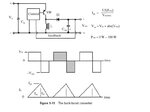TripACT
Member level 3
Hey all,
as part of the project i'm studying and writing about, i need to justify the use of buck converter topology other than boost or buck-boost.
other than it's functionality, what other major differences there are ?
if i want to supply 10v @ 1A for a 10ohm load, why wont i use a boost ? or buck-boost?
i know that output voltage depends on the duty cycle and the duty cycle relationship varies along with the type of the converter.
yet, i'm sure there are other reason why buck is popular and preferred when using low voltages at high ampers...
please provide me with important reasons
UPDATE: just wanted to note that i'm talking about why picking a buck converter from the three classic options: buck, boost, buck-boost
thanks
gary
as part of the project i'm studying and writing about, i need to justify the use of buck converter topology other than boost or buck-boost.
other than it's functionality, what other major differences there are ?
if i want to supply 10v @ 1A for a 10ohm load, why wont i use a boost ? or buck-boost?
i know that output voltage depends on the duty cycle and the duty cycle relationship varies along with the type of the converter.
yet, i'm sure there are other reason why buck is popular and preferred when using low voltages at high ampers...
please provide me with important reasons
UPDATE: just wanted to note that i'm talking about why picking a buck converter from the three classic options: buck, boost, buck-boost
thanks
gary
